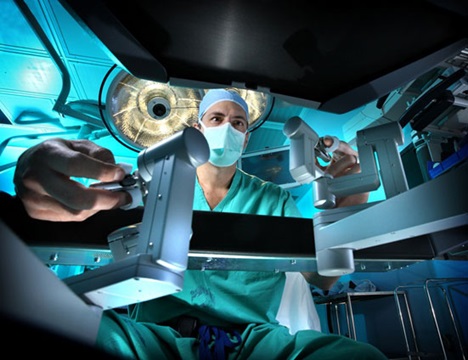Robotic Prostatectomy
Robotic prostatectomy is a minimally invasive procedure performed by an experienced laparoscopic surgery team with the assistance of advanced surgical technology.
Robotic Surgery System

Robotic-assisted radical laparoscopic prostatectomy is accomplished using the da Vinci® Surgical System, a sophisticated robotic surgery system that allows surgeons to operate on the prostate with enhanced vision, control and precision.
Robotic Prostate Surgery Details
Using the advanced surgical system, miniaturized robotic instruments are passed through several small keyhole incisions in the patient’s abdomen to allow the surgeon to remove the prostate and nearby tissues with great precision. This is much less invasive than a conventional radical retropubic prostatectomy, which involves an abdominal incision that extends from the belly button to the pubic bone.
During robotic-assisted radical prostatectomy, a three-dimensional endoscope and image processing equipment are used to provide a magnified view of delicate structures surrounding the prostate gland (e.g., nerves, blood vessels and muscles), allowing optimal preservation of these vital structures. The prostate is eventually removed through one of the keyhole incisions.
For most of the surgery, the surgeon is seated at a computer console and manipulates tiny wristed instruments that offer a range of motion far greater than the human wrist. The surgery is performed without the surgeon's hands entering the patient’s body cavity.
Benefits of Robotic Surgery
Compared with traditional open surgery, patients who undergo robotic-assisted radical prostatectomy experience:
-
Less blood loss
-
Less pain
-
Shorter hospital stays
-
Faster recovery times (although catheter needs to remain in bladder for same amount of time after robotic or open procedure).
Risks of Robotic-Assisted Laparoscopic Radical Prostatectomy
The potential risks of robotic-assisted laparoscopic radical prostatectomy include the following:
-
Bleeding
-
Infection at the surgical site
-
Adjacent tissue/organ damage
Side Effects of Robotic-Assisted Laparoscopic Radical Prostatectomy
The rates of major side effects from robotic-assisted laparoscopic radical prostatectomy are about the same as open surgical approaches. The most common side effects include the following:
-
Urinary incontinence (inability to control urine): Similar to open surgery, urinary incontinence can occur following a robotic prostatectomy. However, this side effect often improves over time.
-
Erectile dysfunction (impotence): The return of erectile function following prostatectomy is based on the patient’s age, degree of preoperative sexual function and whether the nerves were spared during surgery. Unless cancer is suspected in the nerve tissue, surgeons will use nerve-sparing techniques during robotic prostatectomy to minimize the surgical impact on sexual function.
Robotic Prostate Surgery | Q&A
Thanks to advances made by surgeons like Dr. Patrick Walsh, The Brady Urological Institute at Johns Hopkins offers unparalleled prostatectomy expertise. Learn more about prostate cancer surgery and the difference between open and robotic procedures from Dr. Mohamad Allaf.








